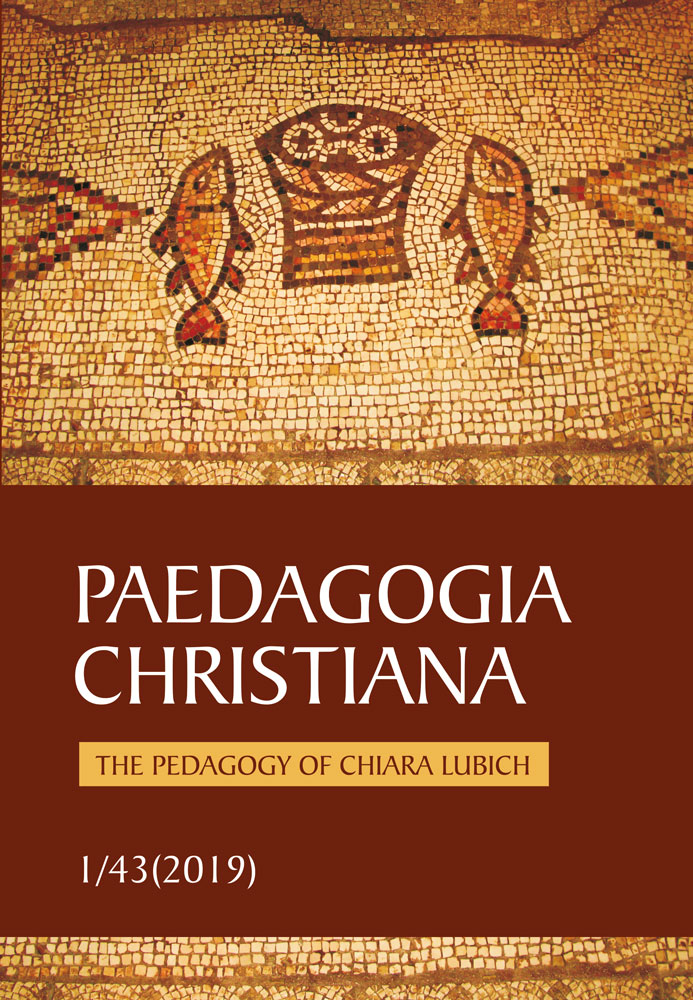Pedagogia braterstwa Chiary Lubich z perspektywy azjatyckiej. Przykład akademickiego kursu „Kultura jedności” na Tajwanie
DOI:
https://doi.org/10.12775/PCh.2019.026Słowa kluczowe
Chiara Lubich, pedagogia braterstwa, kultura jedności, Lubich i AzjaAbstrakt
Chiara Lubich jako założycielka Ruchu Focolari miała ogromny wpływ na kształtowanie się różnych sfer życia i dyscyplin naukowych. Jej myśl stanowi platformę oraz wspólny grunt dla dialogu. Według niej podstawą porozumienia jest miłość i wspólnota, które nie tylko ułatwiają Kościołowi katolickiemu podejmowanie dialogu z innymi kulturami i religiami, lecz również oddziałują na świat akademicki oraz nasze życie codzienne. Spojrzenie Lubich na jedność podpowiada drogę odnowy naszego sposobu myślenia. Odnowienie sposobu myślenia jest początkiem procesu edukacyjnego. Jej duchowość jedności dotarła do Azji w 1966 r. W Azji, gdzie chrześcijaństwo dla większości ludzi jest religią obcą, jej ideał ma szczególnie ważne znaczenie i wpływa na tworzenie jedności między ludźmi. W ostatnich latach azjatyccy naukowcy starają się popularyzować myśl Lubich jako nowy rodzaj metodologii na polu badań i nauczania. Kurs „Kultura jedności” bazujący na myśli mistyczki został zaproponowany na Tajwanie jako sposób rozpowszechniania nowych możliwości edukacyjnych. Ten artykuł ma na celu zbadanie spojrzenia Lubich na edukację oraz jej wpływu na szkolnictwo wyższe na Tajwanie.
Bibliografia
Bergman, Samuel Hugo. Dialogical Philosophy from Kierkegaard to Buber. New York: State University of New York Press, 1991.
Buber, Martin. Between Man and Man. Eastford: Martino Fine Books, 2014.
Choy, Chee, San Oo Pou. “Reflective thinking and the Teaching Practice: A Precursor for Incorporating Critical Thinking into the Classroom?”. International Journal of Instruction 1 (2012): 167-182.
Flecha, Ramón. Sharing Words: Theory and Practice of Dialogue Learning. MD: Rowman and Little field, 2000.
Gabian, Crescencia C. Dialoge, Light and Fire: Chiara Lubich and the Spirituality of Unity. Manila: University of Santo Thomas Publishing House, 2017.
Gendron, Louis. “The Background and Meaning of Chiara Lubich’s Visit to Taiwan” (Lu Jiale laitai de beijing hen Yiyi 盧嘉勒來台的背景和意義). Collectanea Theologica (Shenxue Lunji 神學論集) 111 (2017): 82, 146, 152.
Gross, Edmund. “Dialogue”. In: Encyclopedia Britannica, ed. Hugh Chisholm, vol. 8, 156-157. Cambridge University Press, 1911.
Gross, Mason. Philosophy, Science and Higher Education. Piscataway: Transaction Publishers, 2002.
Huang, Sonja Mei Tin. “The Report on the Conference Patterns of Unity: An Interdisciplinary Dialogue on the Thought of Chiara Lubich (1920-2008)”. Catholic Weekly (Tienzhujiao Zhoubao 天主教週報) 12. 28 April, 2013.
James, Michael, Thomas Masters, Amy Uelmen. Education’s Highest Aim: Teaching and Learning through a Spirituality of Communion. New York: New City Press, 2010.
John Paul II. Crossing the Threshold of Hope. New York: Knopf, 1995.
Leeuw, Karl L. van der. “Philosophical Dialogue and the Search for Truth”. Thinking: the Journal of Philosophy for Children 3 (2004): 1-14.
Lubich, Chiara. Essential Writings: Spirituality Dialogue Culture. London: New City Press, 2007.
Lubich, Chiara. Jesus in our midst. Manila: New City Press, 2003.
Lubich, Chiara. La Dottrina Spirituale. Milano: Mondadori, 2001.
Malebranche, Nicolas. Dialogues on Metaphysics and Religion. Cambridge: Cambridge University Press, 1977.
Maritain, Jacques. Education at the Crossroads. New Haven: Yale University Press, 1966.
Masters, Thomas. “In Pursuit of Education’s Highest Aim: Re-imagining Education through a Spirituality of Communion”. Monthly Review of Philosophy and Culture 10 (2013): 121-137.
Nussbaum, Martha C. Cultivating Humanity: A Classical Defense of Reform in Liberal Education. Cambridge, Massachusetts and London: Harvard University Press, 1997.
Patterns of Unity: An Interdisciplinary Dialogue on the Thought of Chiara Lubich (1920-2008), eds. Sonja Huang Mei Tin, Philipp HU Kungtze. Xinzhuang: Fu Jen Academia Catholica, 2018.
Phillips, Louise. The Promise of Dialogue: The dialogic turn in the production and communication of knowledge. Amsterdam: John Benjamins Publishing Company, 2011.
Singh, Raja Roy. Education for the twenty-first Century: Asia Pacific Perspectives. Bangkok: UNESCO Principal Regional Office, 1991.
Stiglitz, Joseph. “The global crisis, social protection and job”. International Labour Review 1-2 (2009): 1-13.
Xianhai, Li. “From the Rising of Asian Value to the Contemporary Meaning of Confucianism”. Academic Monthly 2 (2006): 53-58.
Xinyi, Ma. “Classic Annotation of Education in Confucian Analects”. Journal of Language and Literary Education 1 (2013): 59-76.
Pobrania
Opublikowane
Jak cytować
Numer
Dział
Statystyki
Liczba wyświetleń i pobrań: 929
Liczba cytowań: 0



